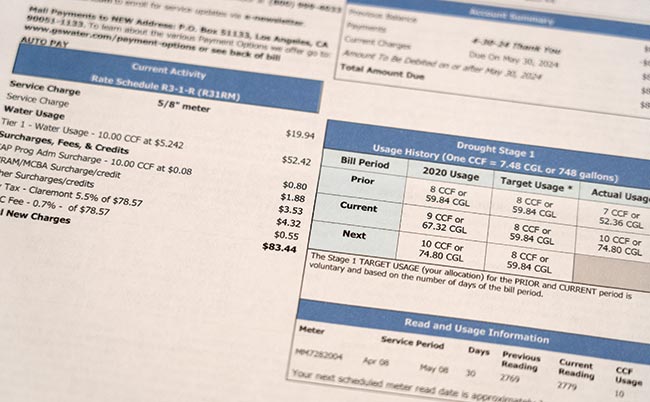Proposed rate increases have Golden State customers outraged … again

Claremont resident Nancy Mintie has rallied consumers to protest a trio of proposed rate hikes by Golden State Water Company over the next three years. Courier photo/Andrew Alonzo
By Andrew Alonzo | aalonzo@claremont-courier.com
A few weeks ago, Claremont resident Nancy Mintie, 70, received an alarming piece of mail. It was from Golden State Water Company, the city’s water supplier, outlining its plans to apply for three rate increases.
“On August 14, 2023, GSWC filed its [General Rate Case] application (A.23-08-010) with the [California Public Utilities Commission],” read the letter. “The application is requesting authorization to increase revenues in the Region 3 service area by $38,917,600 (or 25.33%) for 2025, $7,867,900 (or 4.07%) in 2026, and $8,560,500 (or 4.25%) in 2027. The total requested increase for all three years combined would be $55,346,000 (or 33.65%). If the CPUC approves this application, GSWC will recover forecasted costs in rates over a three-year period beginning January 1, 2025. This will increase your bill.”
“This comes after a 26.5% increase for 2023-2024,” Mintie wrote in a letter to the editor published in the June 7 Courier. “All told, this is a 60% increase in just four years.”
Reached by phone Monday, Mintie said she was “shocked” when reading the notice and said neighbors shared her frustration.
“People are outraged,” said Mintie. “It’s an innocuous looking little folded piece of paper with tiny print that looks like some kind of gobbledygook legal notice. I think for many people they would look at it and say, ‘This is some kind of irrelevant technical legal notice, I don’t need to pay attention to it.’”
But, she said, they should, especially to five key words: “This will increase your bill.”

Claremont resident Nancy Mintie’s bill from Golden State Water Company was $83.44 in May. If a proposed rate hike is approved, her bill could rise to about $112 by 2027. Courier photo/Andrew Alonzo
The water company’s letter outlined how a typical ratepayer would be affected:
“If the proposed application is approved by the CPUC, the average residential customer with a 5/8 x3/4″ meter using 11 Ccf [or cubic feet] (1 Ccf =748 gallons) would see a monthly bill increase of $17.30 (or 24.90%), from $69.49 to $86.79 in 2025, $3.57 (or 4.11%), from $86.79 to $90.36 in 2026, and $3.87 (or 4.28%), from $90.36 to $94.23 in 2027, excluding any applicable surcharges,” the letter explained.
Mintie’s most recent monthly water bill came in at $83.44. If the new rates are approved, it would jump by about $21 in 2025 to roughly $105. The additional proposed 4% increases would see her bill top $112 by 2027.
While concerned about the proposed rate increase on her fixed income budget, the executive director of Claremont nonprofit Uncommon Good is more nervous for the low-income families she works with.
“As the rates for essential services such as electricity and gas and water have gone up, our families haven’t been able to afford to pay them,” Mintie said. “That’s a big concern of mine, that low-income families simply can’t afford these hefty double digit increases and essential services.
“I thought that water is an essential human need and … we’re pricing water, power, and gasoline out of the reach of people on fixed incomes.”
Ben Lewis, Foothill District general manager for GSWC, understands customer’s frustrations with the potential increase, but said as of yet nothing has been finalized between GSWC and the CPUC.
“It’s not done, the CPUC staff is still talking to us,” Lewis said. “I think that more than likely if there is a decision this year it’ll probably be in the fourth quarter of this year. The commission will approve what that number is. We won’t know [the final rate] until the commission comes back and they give us their testimony. Basically, when we get the actual decision, then we’ll start making those investments associated with that.”

Claremont resident Nancy Mintie has rallied consumers to protest a trio of proposed rate hikes by Golden State Water Company over the next three years. Courier photo/Andrew Alonzo
Golden State’s 2023 general rate case application is still under review by CPUC. Every three years the water company submits a rate case application to CPUC, with the proceeds earmarked for infrastructure upgrades. The water company and CPUC are still in the process of deciding which projects are priorities for the 2025-27 cycle and how to get the right rates to fund them, Lewis said.
Proposed projects in the Claremont area include design and permitting of a groundwater well, maintenance and upgrades to plant sites and water treatment facilities, and new systemwide technology. A fact sheet is viewable at gswater.com/claremont, click “2025-27 Proposed Investments/Rates Fact Sheet.”
“The rates proposed for 2025-2027 will provide customers with long-term value by investing over $26.1 million in proactive capital investments and maintenance of local water infrastructure essential to the delivery and treatment of reliable, quality water,” according to the fact sheet.
“Those projects are a series of investments that we believe … allow us to provide the level of customer service that people in Claremont have become accustomed to,” Lewis said.
Lewis said the massive 25% rate increase in 2025 followed by the two smaller increases in 2026 and 2027 will serve to demonstrate to the CPUC action has been taken to get the utility’s proposed projects off the ground.
“We have to make those [initial] investments,” he said. “If we don’t make those investments, that 4% is not guaranteed. In those outer years, that’s the CPUC saying ‘Hey, you said you were going to make these investments; we’re going to check in with you to make sure you’re making those, and if you do that, you get the 4%. And if you don’t, it’ll be lower.’”
Lewis put the blame for rising rates on new water quality regulations and other state mandated health and safety guidelines that are impacting Golden State’s costs. He also said despite conservation efforts by consumers the utility’s costs have risen in part due to matters beyond the company’s control, such as aging infrastructure.
“Many factors impact water rates, including rising operation and maintenance costs, regulatory requirements, and capital improvement programs,” according to GSWC’s website.
Asked what customers can do to reduce their rates, he suggested they explore the various financial assistance programs at gswater.com/assistance-programs.
Mintie has been spreading the word throughout the community and urging people to make their concerns known to the CPUC since receiving the proposed rate increase notice. She’s encouraging people to attend and submit public comment at the 6 p.m. Wednesday, June 26 CPUC virtual public participation hearing regarding Golden State’s general rate case application at adminmonitor.com/ca/cpuc. To attend the meeting by phone, call (800) 857-1917, enter the code 6032788#, and press *1 to comment.
Mintie and some 14 other Claremont residents have already left public comments on the agenda item opposing the rate increases. One, Russell Binder, asked if the rates are warranted. Another, Tim O’Keefe, asked why residents were asked to conserve water in the first place.
To make a general public comment to the CPUC, visit cpuc.ca.gov/pph, and click “region 3” under related documents. Once directed to a new webpage, click the first link on page three. At the new page, click “add public comment.” Fact sheets are also available at cpuc.ca.gov/pph.
Of course, this is not the first time Claremont and Golden State Water Company have been at odds. The well-publicized financial boondoggle that was the failed eminent domain takeover of the utility by the City of Claremont went on for more than a decade before coming to a close in 2017, with the final cost to taxpayers in excess of $10 million.










0 Comments